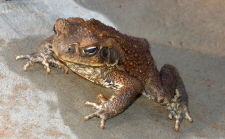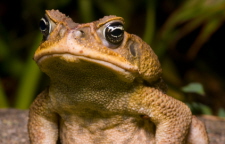Cane Toad in Australia
The Cane Toad is a serious pest in Australia.
They were introduced to northern Queensland in 1935 to try to control the cane beetles.
Now They have spread all the way down the coast of Queensland to New South Wales and across the top of the country towards Western Australia as well as inland to northwest Queensland.
I saw so many of them when I lived in Queensland.
The Cane Toad in Australia can be grey, olive-brown, reddish brown or a yellowy colour. Average-sized adults are 10 to 15 centimetres long. They are large heavy built amphibians.
 They have a bony head, with bony ridges over their eyes. Their hind feet have leathery webbing between the toes and their front feet are unwebbed. They move in short rapid hops.
They have a bony head, with bony ridges over their eyes. Their hind feet have leathery webbing between the toes and their front feet are unwebbed. They move in short rapid hops.
They feed on anything they can fit into their mouth including lizards, snakes, frogs, snails, mice and food left out for pets but most of their food is insects like beetles, bees, ants, and crickets.
Breeding time can be anytime but in Australia it usually starts around September, reaching its peak in January and finishing by March. They lay their eggs in still or slow moving water; the females lay between 8,000 and 30,000 eggs at a time, the eggs hatch in two or three days and the tadpole stage lasts between four and eight weeks.

Cane Toads are poisonous in all stages of their life, from the egg stage to the adult.
Adults produce venom from glands over their upper surface, but especially from bulging glands on their shoulders, and almost anything that eats the toad dies rapidly from heart failure.
Most people in Queensland know someone or know of someone who has had a pet die from getting hold of one of these Toads.
They also kill Australian native animals that have either been eating or mouthing them, these include Goannas, Freshwater Crocodiles, Snakes, Dingoes and the Quoll.
Scientists are searching for ways to control and limit the spread of this invasive species.
Go to next animal page: Freshwater Crocodile
Return to Australian Animals or go to Australian Animal Emblems
Return from Cane Toads to Australian-Information-Stories home page


